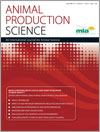
Animal Production Science
Volume 54 Number 4 2014
Muscle Metabolism of Cattle and Sheep in Relation to Meat Quality
AN14098Why is muscle metabolism important for red meat quality? An industry perspective
AN13455Factors influencing the incidence of high rigor temperature in beef carcasses in Australia
The occurrence of high rigor temperature in 1512 beef carcasses in Australia was 75%. Influencing factors for the high incidence included longer duration of electrical contact at the hide puller, grain feeding, heavier carcass weight, steers and higher fatness levels in grass-fed cattle. A combination of on-farm, pre-slaughter and post-slaughter management strategies will be required in order to reduce the incidence of high rigor temperature in beef carcasses, as well as measurements to identify high rigor temperature carcasses.
AN13455 Abstract | AN13455 Full Text | AN13455PDF (892 KB) Open Access Article
AN13329Influence of high pre-rigor temperature and fast pH fall on muscle proteins and meat quality: a review
The rates of pH and temperature decline during rigor development are two of the most important post-mortem factors affecting meat quality. This review discusses the influence of accelerated pH fall at a higher than normal pre-rigor temperature on post-mortem muscle metabolism and meat quality attributes. Gaps in current knowledge are identified and recommendations made for additional research.
AN13329 Abstract | AN13329 Full Text | AN13329PDF (525 KB) Open Access Article
AN12226A consumer sensory study of the influence of rigor temperature on eating quality and ageing potential of beef striploin and rump
Few consumer data are available on the effects of high rigor temperatures on beef eating quality. Analysis of consumer scores for 3865 striploins and 734 rumps showed reduced eating-quality at high rigor temperatures in striploins aged more than 14 days and also in rump. Methods to reduce high rigor temperatures in beef carcasses would improve the acceptability of beef.
AN12226 Abstract | AN12226 Full Text | AN12226PDF (271 KB) Open Access Article
AN12314The effect of pH decline rate on the meat and eating quality of beef carcasses
Producing tender beef is important for consumers and the viability of the beef industry. This research was aimed at understanding the implications for beef quality if carcasses exhibit a fast onset of rigor mortis, a phenomenon that is observed in some beef carcasses. Overall this study did not show detrimental effects of a rapid onset of rigor mortis for product consumed after 14 days of aging.
AN12314 Abstract | AN12314 Full Text | AN12314PDF (282 KB) Open Access Article
AN13309Impacts of hanging method and high pre-rigor temperature and duration on quality attributes of ovine muscles
High pre-rigor temperature can result in adverse impacts on meat quality, and thus developing post-slaughter processing techniques to minimise heat-induced defects is essential. Pre-rigor aitchbone hanging of carcass counteracted the negative effects of high pre-rigor temperature on water-holding capacity and tenderness. Further developing novel hanging/stretching techniques will provide an important protective effect against the heat-induced quality defects.
AN13309 Abstract | AN13309 Full Text | AN13309PDF (292 KB) Open Access Article
AN13454Improving beef meat colour scores at carcass grading
Unacceptably dark meat colour scores are a major cost to the beef industry. Beef carcasses (n = 1512) were assessed for meat colour and 10% were non-compliant for colour. The main causative factors were a short time from slaughter to grading, high final pH, low rigor temperature, older animals and pasture feeding. Attention to these factors can improve meat colour scores at grading.
AN13454 Abstract | AN13454 Full Text | AN13454PDF (322 KB) Open Access Article
AN13303Potential nutritional strategies for the amelioration or prevention of high rigor temperature in cattle – a review
High rigor temperature post-mortem is detrimental to meat quality and is exacerbated by animals being hyperthermic pre-slaughter. Hyperthermia can be the result of increased environmental temperature, exercise and stress, or a combination of these factors. This review explores some of the potential metabolic causes of high rigor temperature, in particular the actions of insulin and leptin, and discusses some potential amelioration strategies such as nutritional supplementation.
AN13303 Abstract | AN13303 Full Text | AN13303PDF (311 KB) Open Access Article
AN13463Grain feeding increases core body temperature of beef cattle
Core body temperatures of steers fed grain or grass were compared for 300 days prior to and 20 hours post-slaughter. Grain feeding increased body temperature ante mortem, reduced the rate of cooling post-mortem and increased the time period for high rigor temperature. Associated changes were increased carcass weight and fatness and most likely other physiological changes as well.
AN13463 Abstract | AN13463 Full Text | AN13463PDF (274 KB) Open Access Article
AN13418Dietary betaine supplementation has energy-sparing effects in feedlot cattle during summer, particularly in those without access to shade
Heat stress is a major cause of production and economic losses in cattle and can lead to health and welfare issues as well as high rigor temperature post-mortem. This study explored the use of shade and an organic dietary supplement, betaine, to combat heat stress in feedlot cattle. Betaine supplementation was shown to alter aspects of meat quality and gene expression. The use of betaine as a dietary supplement may therefore improve animal production and prevent welfare issues in feedlot cattle during summer.
AN13418 Abstract | AN13418 Full Text | AN13418PDF (245 KB) Open Access Article
AN12379Relationship between changes in core body temperature in lambs and post-slaughter muscle glycogen content and dark-cutting
Body temperature monitoring used in research on animal stress could help to prevent dark-cutting meat. A significant negative correlation was detected between elevation in core body temperature due to physical stress of sheep and muscle glycogen levels at slaughter. Changes in body temperature pre-slaughter in lambs show a potential for enabling prediction of muscle glycogen levels and dark-cutting post-slaughter, and to propose changes in protocols of animal handling.
AN12379 Abstract | AN12379 Full Text | AN12379PDF (171 KB) Open Access Article
AN13088Regulation of post-mortem glycolysis in ruminant muscle
The rate and extent of post-mortem glycolysis in muscle can have profound effects on both the visual and sensory attributes of meat. This review examines the regulation of post-mortem energy metabolism in muscle and introduces new perspectives from other non-meat science disciplines. Although glycolysis and its regulation are reasonably well understood, knowledge gaps remain.
AN13088 Abstract | AN13088 Full Text | AN13088PDF (375 KB) Open Access Article
AN12338Techniques to reduce the temperature of beef muscle early in the post mortem period – a review
High temperature with low pH reduces the quality of deep muscles in large beef carcasses. A review of the literature was conducted with a focus on the cooling rate of beef carcasses in the first 5 hours post slaughter. This can be achieved by reducing body temperature in both the ante and post mortem periods using a range of methods.
AN12338 Abstract | AN12338 Full Text | AN12338PDF (235 KB) Open Access Article
AN13062Pre-rigor carcass stretching counteracts the negative effects of high rigor temperature on tenderness and water-holding capacity – using lamb muscles as a model
This study evaluated the effects of electrical stimulation, high pre-rigor temperature and stretching of lamb sides on quality traits and protein denaturation in four leg muscles (gluteus medius, rectus femoris, semimembranosus and semitendinosus). Pre-rigor stretching of lamb sides can counteract the negative effects of high early post-mortem temperature on tenderness and water-holding capacity.
AN13062 Abstract | AN13062 Full Text | AN13062PDF (747 KB) Open Access Article
AN13001A preliminary study into the use of ‘heat pipes’ to prevent high rigor temperature in beef carcasses by increasing cooling rate
The cooling rate in large carcasses is limited by the low thermal conductivity of meat. Three experiments investigated the use of heat pipes to overcome this problem. The results suggested that heat pipes could increase the rate of heat loss, and be used to reduce the risk of high rigor temperature in leg muscles of heavy beef carcasses.
AN13001 Abstract | AN13001 Full Text | AN13001PDF (928 KB) Open Access Article
AN13437Muscle metabolism in sheep and cattle in relation to high rigor temperature – overview and perspective
A large number of Australian carcasses do not to meet the Meat Standards Australia (MSA) pH–temperature window, due to high rigor temperatures. This overview discusses the outcomes of an extensive research program on ante- and post-mortem factors related to heat-induced toughening in beef and sheep meat. An entire supply-chain approach is suggested to establish the most efficient and cost-effective way of reducing the incidence of high rigor temperature.
AN13437 Abstract | AN13437 Full Text | AN13437PDF (181 KB) Open Access Article



